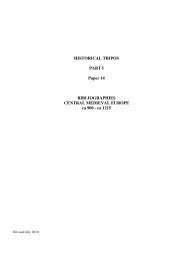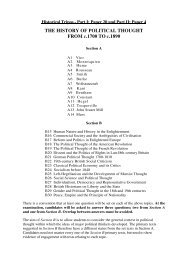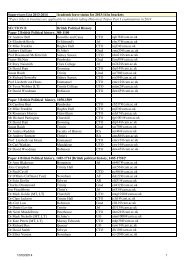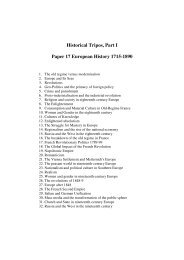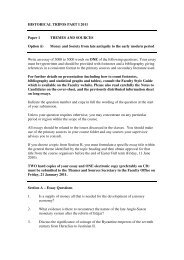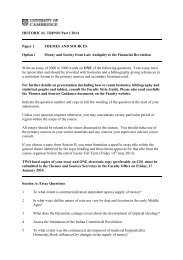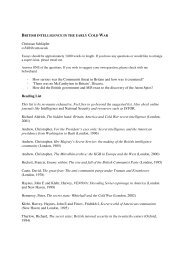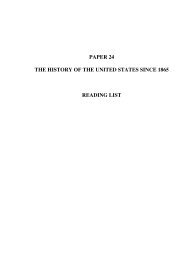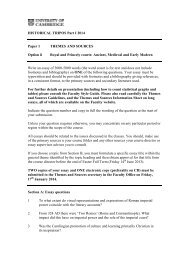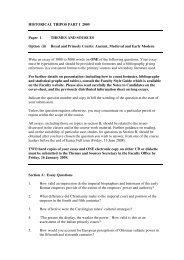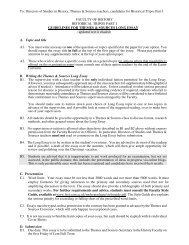Course Handbook - Faculty of History - University of Cambridge
Course Handbook - Faculty of History - University of Cambridge
Course Handbook - Faculty of History - University of Cambridge
Create successful ePaper yourself
Turn your PDF publications into a flip-book with our unique Google optimized e-Paper software.
indication that the authorship is not your own and due acknowledgement <strong>of</strong> the<br />
source;<br />
• paraphrasing the critical work <strong>of</strong> others without due acknowledgement – even if<br />
you change some words or the order <strong>of</strong> the words, this is still plagiarism if you are<br />
using someone else’s original ideas and are not properly acknowledging it;<br />
• using ideas taken from someone else without reference to the originator;<br />
• cutting and pasting from the Internet to make a "pastiche" <strong>of</strong> online sources;<br />
• colluding with another person, including another candidate (other than as might be<br />
permitted for joint project work);<br />
• submitting as part <strong>of</strong> your own report or dissertation someone else’s work without<br />
identifying clearly who did the work (for example, where research has been<br />
contributed by others to a joint project) or submitting work that has been undertaken<br />
in whole or in part by someone else on your behalf (such as employing a ‘ghost<br />
writing service’);<br />
• submitting work you have submitted for a qualification at another institution without<br />
declaring it and clearly indicating the extent <strong>of</strong> overlap;<br />
• deliberately reproducing someone else’s work in a written examination..<br />
c) Plagiarism can occur in respect to all types <strong>of</strong> sources and all media:<br />
• not just text, but also illustrations, musical quotations, computer code etc;<br />
• not just text published in books and journals, but also downloaded from websites or<br />
drawn from other media;<br />
• not just published material but also unpublished works, including lecture handouts<br />
and the work <strong>of</strong> other students.<br />
2 How to avoid plagiarism<br />
The stylistic conventions for different subjects vary and you should consult your course director or<br />
supervisor about the conventions pertaining in your particular subject area. Most courses will issue<br />
written guidance on the relevant scholarly conventions and you are expected to have read and to<br />
follow this advice. However, the main points are:<br />
• when presenting the views and work <strong>of</strong> others, you must give an indication <strong>of</strong> the<br />
source <strong>of</strong> the material; conventions for this vary, but one approach would be to write:<br />
'... as Sharpe (1993) has shown', and give the full details <strong>of</strong> the work quoted in your<br />
bibliography;<br />
• if you quote text verbatim, make this completely evident; again conventions will vary<br />
but you might say: 'The elk is <strong>of</strong> necessity less graceful than the gazelle' (Thompson,<br />
1942, p 46) and give the full details in your bibliography as above;<br />
• if you wish to set out the work <strong>of</strong> another at length so that you can produce a counterargument,<br />
set the quoted text apart from your own text (e.g. by indenting a paragraph)<br />
and identify it in a suitable way (e.g. by using inverted commas and adding a reference<br />
as above). NB long quotations may infringe copyright, which exists for the life <strong>of</strong> the<br />
author plus 70 years.<br />
• if you are copying text, keep a note <strong>of</strong> the author and the reference as you go along,<br />
with the copied text, so that you will not mistakenly think the material to be your own<br />
work when you come back to it in a few weeks' time;<br />
• if you reproduce an illustration or include someone else's data in a graph or table,<br />
include the reference to the original work in the legend, e.g. '(figure redrawn from<br />
Webb, 1976)' or '( 1 = data from Webb, 1976);<br />
• if you wish to collaborate with another person on your project, you should check with<br />
your supervisor whether this might be allowed and then seek permission (for research<br />
degrees, the permission <strong>of</strong> the Board <strong>of</strong> Graduate Studies must be sought);<br />
• if you have been authorised to work together with another candidate or other<br />
27




